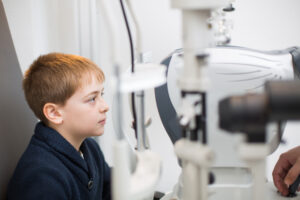Plaquenil (hydroxychloroquine), a commonly prescribed medication for autoimmune conditions such as rheumatoid arthritis, lupus, certain types of malaria, and more, wields its influence on the eyes, particularly with prolonged use. It is imperative to note that the ocular effects are relatively scarce, especially when Plaquenil adheres to the recommended doses and receives regular scrutiny from a rheumatologist and eye care professional. Factors that augment the risk of retinal toxicity encompass hefty daily doses, protracted usage (over several years), and specific underlying retinal conditions. Below, we explore the known impacts of Plaquenil on the eyes, and why yearly eye examinations hold paramount importance for patients on this drug:
Retinal Toxicity: The most consequential concern linked to Plaquenil usage lies in the peril of retinal toxicity. Overextended consumption of Plaquenil in high doses can potentially ravage the cells in the retina, the light-sensitive tissue located at the rear of the eye. Retinal toxicity is an uncommon occurrence but can result in permanent vision loss if not promptly detected.
Macular Damage: Plaquenil toxicity predominantly targets the central part of the retina, known as the macula. Macular damage can engender blurred or distorted central vision, reading difficulties, and diminished color perception.
Visual Field Defects: In certain instances, Plaquenil toxicity can culminate in the emergence of visual field defects. This implies that there may be areas of diminished or absent vision in the peripheral (side) vision.
Corneal Deposits: Plaquenil utilization can occasionally give rise to the accumulation of deposits in the cornea, the transparent front surface of the eye. These deposits can induce a sensation of glare or halos around lights and may impede visual clarity.
To mitigate the risk of ocular complications, individuals consuming Plaquenil should adhere to the ensuing recommendations:
Regular Eye Examinations: It is of paramount importance to undergo baseline eye examinations before commencing Plaquenil therapy, followed by subsequent eye exams at regular intervals as directed by your healthcare provider. These assessments typically encompass specialized tests to evaluate the retinal health, such as visual field testing and optical coherence tomography (OCT) scans.
Dose Adjustment: Plaquenil dosage should be customized based on body weight and aligned with guidelines to ensure it remains within the boundaries of safety. Your healthcare provider will guide you through this recommendation.
Awareness of Symptoms: Stay vigilant for any visual alterations or symptoms such as blurred vision, difficulty reading, or any other atypical visual disturbances. If you encounter any of these symptoms, promptly notify your healthcare provider.
Communication with Healthcare Provider: Keep your healthcare provider and eye care professional informed about your Plaquenil usage, any pre-existing eye conditions, or any family history of retinal problems. This information can aid in the monitoring and management of potential ocular complications.
Working closely with your healthcare provider and eye care professional is essential to oversee your eye health while taking Plaquenil. Consistent screenings and adherence to recommended guidelines can facilitate early detection of any potential ocular effects and avert long-term vision impairments.









